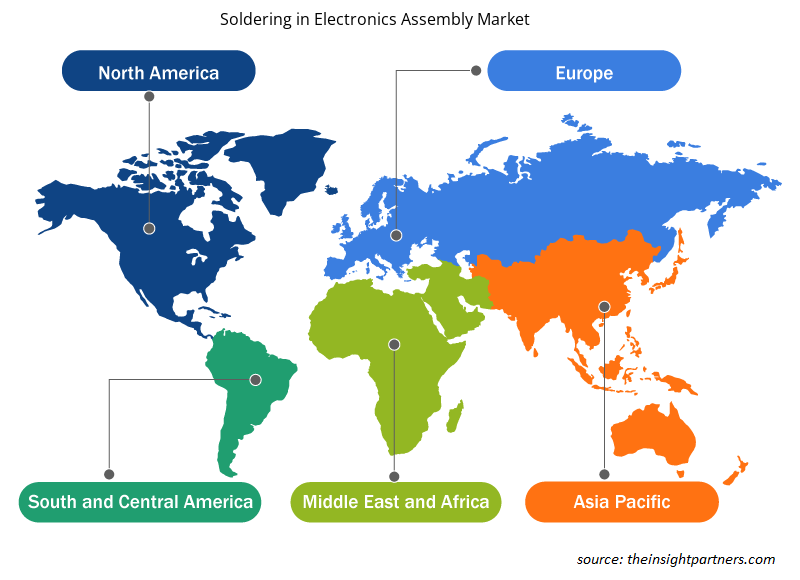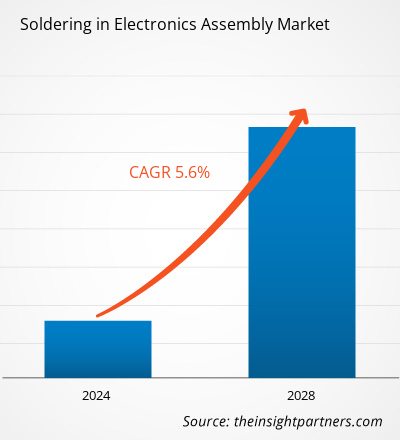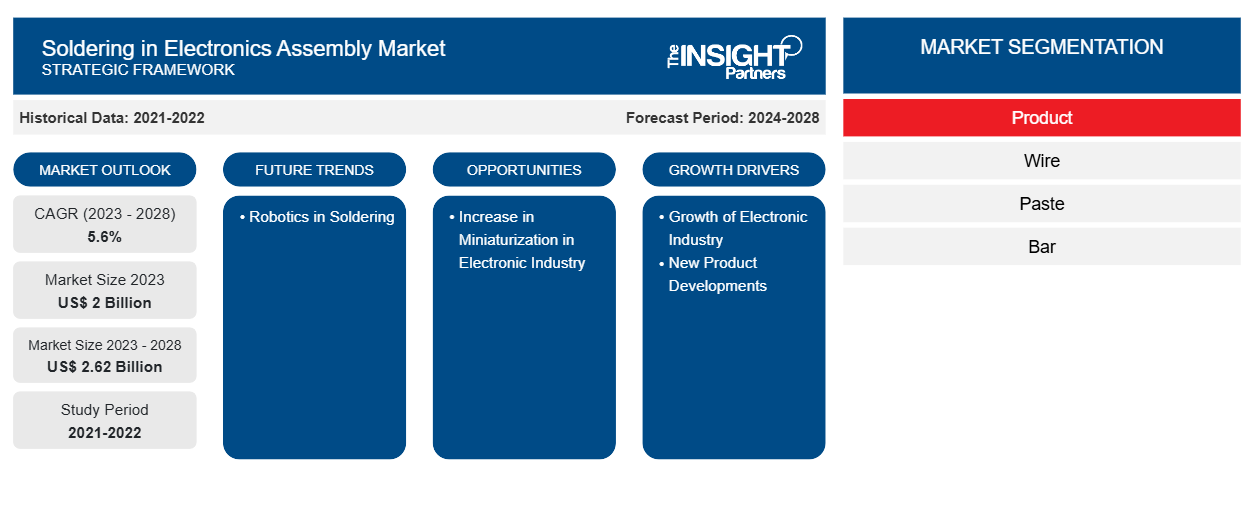[Rapporto di ricerca] Si prevede che il mercato della saldatura nell'assemblaggio di componenti elettronici crescerà da 2.001,96 milioni di dollari nel 2023 a 2.624,71 milioni di dollari entro il 2028; si stima che registrerà un CAGR del 5,6% dal 2023 al 2028.
La miniaturizzazione dei componenti elettronici svolge un ruolo importante nell'industria elettronica. Aiuta a risparmiare spazio in modo che possano essere integrate parti o tecnologie aggiuntive, o le dimensioni complessive di elettronica di consumo, dispositivi medici, automobili e altro possono essere ridotte. Ad esempio, le dimensioni ridotte delle batterie aiutano nella miniaturizzazione dei computer. Inoltre, la miniaturizzazione aiuta a risparmiare sul costo del materiale complessivo utilizzato. Per i componenti in miniatura, viene utilizzato meno materiale per la saldatura, il che aiuta a risparmiare sul costo del materiale utilizzato rispetto ai componenti o dispositivi di dimensioni normali. Tali vantaggi della miniaturizzazione stanno alimentando la domanda di questa tecnica nel mercato dell'elettronica. Inoltre, la domanda di paste saldanti con dimensioni delle particelle metalliche più piccole per la miniaturizzazione spinge la saldatura nella crescita del mercato dell'assemblaggio elettronico. INVENTEC, con sede in Francia, fornisce la pasta saldante Ecorel Free JP32 e Ecorel Free HT 235-16LVD, che può essere utilizzata nella miniaturizzazione per applicazioni di produzione di elettronica a passo ultra fine. L'azienda sta sviluppando più prodotti di pasta saldante a causa della crescente domanda di miniaturizzazione. Pertanto, si prevede che l'aumento della miniaturizzazione nell'industria elettronica offrirà opportunità di crescita per la saldatura nel mercato dell'assemblaggio di componenti elettronici.
Saldatura nel mercato dell'assemblaggio elettronico -
Personalizza questo report in base alle tue esigenze
Riceverai la personalizzazione gratuita di qualsiasi report, comprese parti di questo report, o analisi a livello nazionale, pacchetto dati Excel, oltre a usufruire di grandi offerte e sconti per start-up e università
-
Scopri le principali tendenze di mercato in questo rapporto.Questo campione GRATUITO includerà analisi di dati che spaziano dalle tendenze di mercato alle stime e alle previsioni.
Impatto della pandemia di COVID-19 sul mercato della saldatura nell'assemblaggio elettronico
La pandemia di COVID-19 ha causato interruzioni nei settori manifatturieri, con un impatto su ogni processo, dalla catena di fornitura e dalle operazioni alla spesa in conto capitale, prestiti e strategie a lungo termine. La pandemia ha interrotto le esportazioni di componenti e la produzione su larga scala. Secondo la Conferenza delle Nazioni Unite sul commercio e lo sviluppo (UNCTAD), gli investimenti diretti esteri (IDE) globali sono crollati del 42% nel 2020 rispetto al 2019. I prezzi dello stagno e del piombo sono aumentati durante la pandemia, determinando un calo della domanda di prodotti per saldatura. D'altro canto, la domanda di dispositivi medici come pacemaker, defibrillatori, neurostimolatori, ecografi e pompe per infusione è aumentata a causa della pandemia. Inoltre, la cultura del lavoro da casa e la scuola online sono alcuni fattori che hanno aumentato la domanda di laptop e cellulari durante la pandemia. Ad esempio, Lenovo ha registrato dati finanziari significativi nel secondo trimestre del 2020 grazie all'adozione del modello di lavoro da casa; è aumentato del 7% su base annua. Pertanto, l'impatto del COVID ha causato interruzioni negative nell'attività di saldatura nel mercato dell'assemblaggio di componenti elettronici.
Approfondimenti di mercato – Saldatura nel mercato dell’assemblaggio elettronico
Nel corso degli anni, Cina e India hanno aumentato significativamente i loro investimenti per sviluppare il loro settore manifatturiero. Questi paesi hanno anche avviato iniziative come Made in China 2025 e Make in India per promuovere la produzione locale. Inoltre, la presenza di manodopera a basso costo sta spingendo il rapido sviluppo del settore manifatturiero in India e Cina, rendendo questi paesi hub per la produzione di elettronica di consumo e componenti elettronici come PCB, sensori, dischi rigidi e schede madri . Inoltre, l'aumento degli investimenti da parte di aziende globali in settori come la produzione di dispositivi medici, l'elettronica e l'automotive per allestire i loro impianti di produzione in tutta la regione dovrebbe ulteriormente contribuire alla crescita del mercato della saldatura nell'assemblaggio di componenti elettronici APAC nei prossimi anni.
Approfondimenti sui prodotti
In base al prodotto, la dimensione del mercato della saldatura nell'assemblaggio di componenti elettronici è segmentata in filo, pasta, flusso, barra e altri. Il segmento del filo ha rappresentato la quota di mercato maggiore nel 2022. I fili per saldatura sono disponibili in una gamma di spessori, tipi e metodi di saldatura. Il filo per saldatura manuale, la saldatura laser e la saldatura a ferro automatizzata sono tra i metodi di saldatura comunemente utilizzati. In base alla composizione, sul mercato sono disponibili fili per saldatura con e senza piombo. I fili per saldatura senza piombo sono utilizzati nella maggior parte delle applicazioni per rispettare la direttiva RoHS. Il filo per saldatura senza piombo ha forti proprietà di bagnatura poiché contiene il 3% di argento. Il filo per saldatura senza argento consente di risparmiare sui costi operativi dell'assemblaggio elettronico.
Il filo di saldatura con anima di flusso è utilizzato in vari processi, tra cui la saldatura automatizzata e robotica. Il filo con anima di flusso CW-818 prodotto da Indium Corporation offre una rapida velocità di bagnatura per ridurre al minimo i tempi di ciclo nei processi di saldatura manuali e robotici; questo filo presenta resistenza al calore e proprietà di bassa emissione di spruzzi del flusso di nucleo, fornendo così assemblaggi migliori per i processi di saldatura manuali e robotici.
Approfondimenti regionali sul mercato dell'assemblaggio di componenti elettronici e saldatura
Le tendenze regionali e i fattori che influenzano il mercato della saldatura nell'assemblaggio di componenti elettronici durante il periodo di previsione sono stati ampiamente spiegati dagli analisti di Insight Partners. Questa sezione discute anche i segmenti e la geografia del mercato della saldatura nell'assemblaggio di componenti elettronici in Nord America, Europa, Asia Pacifico, Medio Oriente e Africa e America meridionale e centrale.

- Ottieni i dati specifici regionali per la saldatura nel mercato dell'assemblaggio elettronico
Ambito del rapporto di mercato sulla saldatura nell'assemblaggio di componenti elettronici
| Attributo del report | Dettagli |
|---|---|
| Dimensioni del mercato nel 2023 | 2 miliardi di dollari USA |
| Dimensioni del mercato entro il 2028 | 2,62 miliardi di dollari USA |
| CAGR globale (2023 - 2028) | 5,6% |
| Dati storici | 2021-2022 |
| Periodo di previsione | 2024-2028 |
| Segmenti coperti |
Per Prodotto
|
| Regioni e Paesi coperti |
America del Nord
|
| Leader di mercato e profili aziendali chiave |
|
Densità degli attori del mercato dell'assemblaggio di componenti elettronici e saldatura: comprendere il suo impatto sulle dinamiche aziendali
Il mercato della saldatura nell'assemblaggio di componenti elettronici sta crescendo rapidamente, spinto dalla crescente domanda degli utenti finali dovuta a fattori quali l'evoluzione delle preferenze dei consumatori, i progressi tecnologici e una maggiore consapevolezza dei vantaggi del prodotto. Con l'aumento della domanda, le aziende stanno ampliando le loro offerte, innovando per soddisfare le esigenze dei consumatori e capitalizzando sulle tendenze emergenti, il che alimenta ulteriormente la crescita del mercato.
La densità degli operatori di mercato si riferisce alla distribuzione di aziende o società che operano in un particolare mercato o settore. Indica quanti concorrenti (operatori di mercato) sono presenti in un dato spazio di mercato in relazione alle sue dimensioni o al valore di mercato totale.
Le principali aziende che operano nel mercato della saldatura nell'assemblaggio di componenti elettronici sono:
- Lucas-Milhaupt, Inc
- GENMA Europe GmbH
- Tecnologia S-Bond
- Fusione incorporata
- Società di indio
Disclaimer : le aziende elencate sopra non sono classificate secondo un ordine particolare.

- Ottieni la panoramica dei principali attori del mercato della saldatura nell'assemblaggio elettronico
La dimensione del mercato globale della saldatura nell'assemblaggio di componenti elettronici è segmentata in base al prodotto. In base al prodotto, il mercato è segmentato in filo, pasta, flusso, barra e altri. Per regione, il mercato della saldatura nell'assemblaggio di componenti elettronici è segmentato in Nord America, Europa, Asia Pacifico (APAC), Medio Oriente e Africa (MEA) e Sud America (SAM).
GENMA Europe GmbH, Indium Corporation, Fusion Incorporated, AIM Metals & Alloys LP e MacDermid Alpha Electronics Solutions sono tra i principali attori del mercato della saldatura nell'assemblaggio di componenti elettronici che operano a livello mondiale.
Gli operatori del mercato della saldatura nell'assemblaggio di componenti elettronici si concentrano principalmente sullo sviluppo di prodotti avanzati ed efficienti.
- Nel 2021, il fornitore di servizi di produzione elettronica "Foxconn Technology Group" e la società di semiconduttori "MediaTek" hanno annunciato una collaborazione per sviluppare nuove soluzioni 5G per applicazioni di produzione intelligente e Industria 4.0. Questa collaborazione potrebbe portare a nuovi progressi nel settore dell'elettronica di saldatura.
- Nel 2020, il produttore di apparecchiature per saldatura "Metcal" ha stretto una partnership con il distributore di prodotti elettronici "Farnell" per ampliare la propria offerta di prodotti e raggiungere nuovi clienti in Europa.
- Analisi storica (2 anni), anno base, previsione (7 anni) con CAGR
- Analisi PEST e SWOT
- Valore/volume delle dimensioni del mercato - Globale, Regionale, Nazionale
- Industria e panorama competitivo
- Set di dati Excel
Report recenti
Testimonianze
Motivo dell'acquisto
- Processo decisionale informato
- Comprensione delle dinamiche di mercato
- Analisi competitiva
- Analisi dei clienti
- Previsioni di mercato
- Mitigazione del rischio
- Pianificazione strategica
- Giustificazione degli investimenti
- Identificazione dei mercati emergenti
- Miglioramento delle strategie di marketing
- Aumento dell'efficienza operativa
- Allineamento alle tendenze normative























 Ottieni un campione gratuito per - Saldatura nel mercato dell'assemblaggio elettronico
Ottieni un campione gratuito per - Saldatura nel mercato dell'assemblaggio elettronico